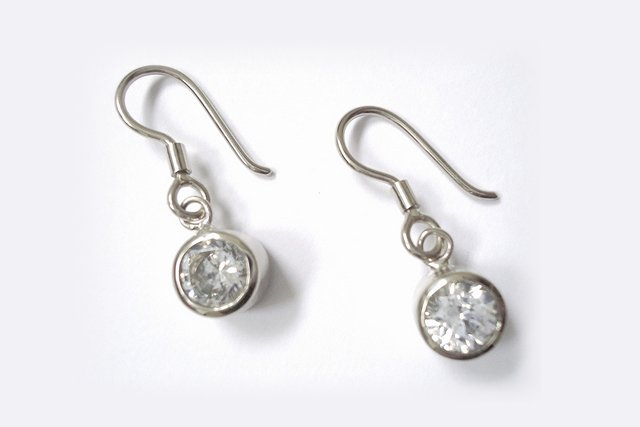Not all people are blessed with a skin that can handle all types of jewelry. Some have allergic reactions on different types of metals, so hypoallergenic jewelry is a must if they want to accessorize.
There are types of metals that commonly cause allergies and contact dermatitis, like nickel and cobalt. These allergies appears as an itchy or painful reaction that only appears on the part of the skin exposed to the metal. It can take the form of an itchy rash to uncomfortable peeling and blisters. Other metals, like copper, can leave an ugly green residue on your skin due to oxidation after prolonged exposure.
The best way to overcome the allergy and still be able to wear great-looking jewelry, here’s what you need to do:
1. Stay away from nickel jewelry.
Have you ever experienced having a crusty residue on your skin after taking off a piece of jewelry? You may have nickel allergy. This is a popular metal among lower-priced jewelry because it’s durable, cheap to produce and has a high polish. It also accounts for most metal allergies, since as the nickel dissolves in water, it creates salt, which means the metal is eroding. If you wear it in areas that collect sweat and moisture, the process of the eroding of metal spreads the metal out and rubs it into your skin. This affects sensitive skin, especially if you wear binding jewelry like rings, or even necklaces. Nickel is also bad for body jewelries that come in direct contact with your interior flesh, like tongue or nose earrings, because salt will quickly form and irritate that area.
Copper is another common metal allergen used in alloys for jewelry. Its oxidation process can also cause the skin to turn green.
2. Invest in fine hypoallergenic jewelry.
When it comes to buying jewelry, it’s best to think about what you can have and hold for a long time. Instead of buying cheap to save a few bucks, think about how benefits of investing in quality jewelry. Choosing jewelry with higher levels of purity means fewer alloys are added. And when fewer metals are added, it’s less likely to cause allergic reactions and contact dermatitis. Better quality jewelry also won’t scratch or tarnish as easily as many affordable jewelry. A 24k gold bracelet or platinum necklace would last for decades, plus, you can even give it as an heirloom for your children, so a higher price tag would be worth it.
3. Buy gold that’s 14k or higher.
When buying gold jewelry, it’s best to choose something that’s 14 karat or higher. Karat is the measure of purity for gold, and the higher the karat, the higher the ratio of gold to alloys. A 24 karat gold piece is considered 99.5 percent pure gold. Anything below 14k means that at least half of the jewelry is made of other alloys, which can be copper or brass. When buying gold, choose a piece in either 14k, 18k or 24k yellow gold or rose gold. If you’re choosing white gold because you want a more silver color, choose 18k or higher. When choosing gold-plated jewelry, choose something that has sterling silver as a base metal.
4. Choose platinum, sterling silver or stainless steel.
Besides gold, you can invest in platinum pieces. Platinum is malleable yet durable, and it doesn’t have to be alloyed with other metals such as nickel. Sometimes it’s alloyed with iridium, but it doesn’t cause allergic reactions. Sterling silver is also recommended – “sterling” or “925” means the jewelry is 92.5 percent pure. Avoid those plated with silver, since most of the time, brass or copper is underneath. Most stainless steel pieces are also hypoallergenic, plus it is budget-friendly.
5. Opt for zinc or palladium alloys.
If buying pure jewelry is too expensive for you, opt for alloys that contain palladium or zinc, instead of copper or nickel. Zinc and palladium are skin-friendly. Palladium is a white metal related to platinum, and it’s hypoallergenic, pure and more affordable because it’s less dense. Zinc alloy, or Tibetan Silver, is a common jewelry component because it’s versatile and affordable.
6. Use metal-testing kits.
To be sure, consider buying metal testing kits so you can know for yourself the purity of any jewelry. By simply dropping a solution from the metal testing kit into a cotton ball and then rubbing it against any area of your jewelry, a reaction will change the color of the solution. This will alert you presence of certain metals that can cause allergic reactions. This is helpful if you’re buying jewelrieswhen you’re unsure what really is it made of.
7. Be careful with leather jewelry.
If you are sensitive to most jewelry, perhaps it’s best to avoid leather as well. It sounds unlikely, but what most people do not know is that metal is involved in the leather tanning process, as mineral tanning produces stretchable leather faster than vegetable tanning. Leather handbags and garments, including leather jewelry like armbands, may carry traces of metals that can cause itch and rashes. If you like the look of leather jewelry, it’s better if you go for pleather.
8. Remove your rings before washing your hands.
There are people who can’t wear their wedding or engagement rings on the finger for too long, due to itchy red rashes that appears to the part of the finger that comes in contact with the metal. However, sometimes the allergic reactions are not just brought by the metal. One can also get contact dermatitis on the fingers (sometimes called wedding ring dermatitis) from bacteria buildup or irritations caused by soap, water or lotions getting caught under the ring and reacting with the metal. To prevent this rashes from appearing remove your ring before washing your hands, taking a shower or bath, or putting on lotions and other body products, so that they won’t get under the ring and irritate your skin. Also, make it a habit to send your ring to the jeweler regularly so dirt and bacteria won’t build up on it. Better yet, own a jewelry cleaner, especially if your household owns lots of jewelries.
9. Be careful about body jewelry.
Jewelry that comes in direct contact with your body – like those earrings you put in piercings in the tongue, navel, nose, etc. – can out yourself at risk not only for allergies but also for severe infection. When you buy body jewelry, pick those that are labeled “nickel-free” or “surgical.” These jewelries must also always be routinely cleaned.




